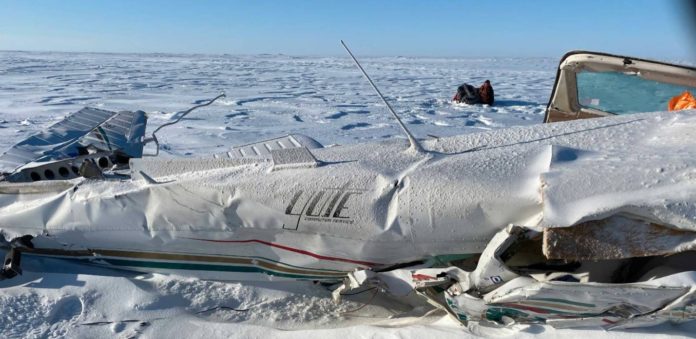By COLLEEN MONDOR | AINONLINE
On Sept. 7, two-and-a-half years after the crash of a Yute Commuter Service single-engine Piper PA-32 near Tuntutuliak, Alaska, the National Transportation Safety Board released its probable cause finding on the five-fatality accident, citing a pilot’s decision to fly into potentially whiteout conditions.
But a lengthy investigation also pointed to systemic safety issues and lax procedures that enabled the decision-making.
The PA-32 departed under a special VFR on the morning of Feb. 6, 2020, for the village of Kipnuk, less than 100 miles from the company base in Bethel. It crashed about 30 minutes later, at approximately 11:10 a.m. local time.
Investigators determined the decision of the pilot, Tony Matthews, to continue VFR into “reduced visibility, including likely flat light and/or whiteout conditions,” was the probable cause. Matthews had 645 hours of total time; the Kipnuk flight was only his fourth revenue trip for the company.
As a contributory factor, the NTSB also found Yute’s operational control procedures were inadequate and “permitted” the pilot to depart below company minimums.
Aviation writer Colleen Mondor untangles the story at Aionline.com.

I was involved in thre planning for the current Tuntutuliak Airport among others in the YK Delta. The flat light conditions can change incredibly quickly causing disorientation. Most of the crashes are with inexperienced pilots who do not have IFR ratings. Nobody wants to bear the cost of training IFR for entry commuter pilots, a cost of living in the Bush.
What good would it do for entry level pilots to have IFR training when none of the airports have IFR capability? Only the major hubs have IFR capability. Maybe there is some sort of IFR Lite that could be required out there. I know from my experience with operating a boat in poor visibility; you have to make yourself reject your senses and trust your instruments. Flat light, white-out or whatever, that airplane still had an operating altimeter and air-speed indicator. If I have airspeed and altitude, all I need is ideas.
Art, most every village in Alaska has a GPS approach. The minimums are higher than a standard approach but a GPS approach does allow below vfr minimums attempts at landing.
P___-poor management by Alaska commuter airlines raises the cost of everything in Alaska. The plaintiffs against this airline will typically collect the maximum amount of insurance as required of the airline by the FAA. The insurance companies must pass the cost along to the Alaska airlines, and in turn the costs for freight and passenger seats rise. For example, REAAs paying for the cost of transporting school administrators and teachers experience cost increases and pass the cost along to the state. So the proposed $1,000 per student BSA increase would not go as far because of this decision to allow a very low-time commercial pilot to fly VFR in IFR conditions.
Everybody who flies in rural Alaska should read the linked article. I rattled around rural Alaska in beat up Cessnas back in the early ’80s. I was young and immortal and am still here to tell the tale, but I did get a broken nose and a dislocated shoulder as remembrances. I hope to never fly in a small plane ever again. The tw most common epitaphs in Alaska are, “Controlled flight into terrain” and “VFR flight into IFR conditions.”
Oddly There is no mention of another contributing factor….FAA reviews and certifies the operations plan for all Part 135 and Part 121 carriers. In this case, if the operations control procedures from the operations plan ‘allowed’ the pilot to depart when he should not have, the onus is shared in a significant way by the FAA.
Don’t Part 135 operators have a ton of lee-way when it comes to operations? My understanding is they are barely more regulated than Part 91 guys.
Well folks … if you’re ever lived in bush Alaska you will grow to love and appreciate bush pilots.
I, alone as a woman, was challenged to fly into rural communities in bush Alaska as a Child Protection Officer… when you land you’re not popular and you have absolutely no back up at all…NONE. The state is screwed up to allow this but they do.
I had pilots wait for me on the runway while I snatched up kids from abusive situations and fly me to safety.
Alaska flying is unforgiving but extremely necessary and these young pilots that helped me over the years deserve wings of gold. I could’ve never survived rural Alaska without them. Regardless if they were with Yute, Grant whatever….they were there. And I applaud the operators that can work in bush Alaska… it’s a tough job.
Pray for them always. They’re unsung heroes in bush Alaska.